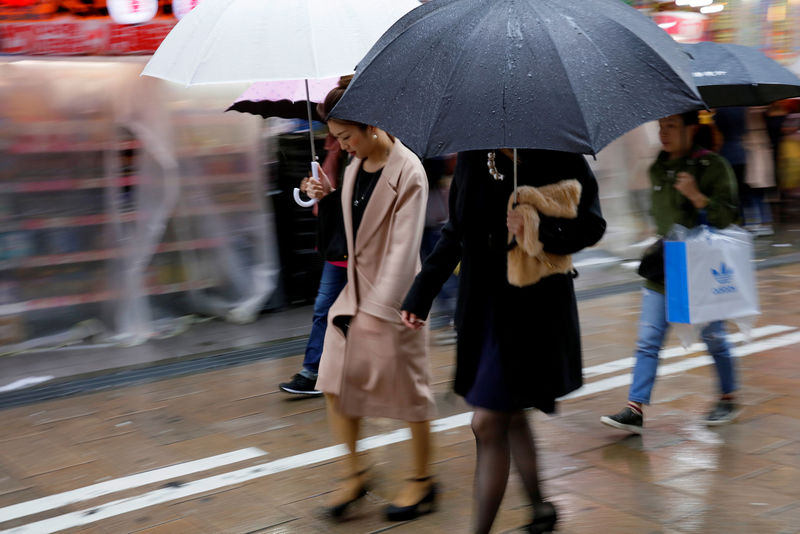 © Reuters. FILE PHOTO: Shoppers walk through the rain in an Osaka shopping district
© Reuters. FILE PHOTO: Shoppers walk through the rain in an Osaka shopping districtBy Leika Kihara
TOKYO (Reuters) – Japan’s inflation in December continued to lag a strong economic revival, leaving the central bank in a dilemma on how to turn off crisis-era stimulus policies that even some of its own board members warn will start to hurt more than help if retained for too long.
Adding to the complication over the Bank of Japan’s exit-timeline is a recent rise in the yen, which would make it even harder to vanquish deflation that has beset the world’s third-biggest economy for decades.
Government data released on Friday gave little hope on the inflation front, with core prices last month rising 0.9 percent year-on-year, unchanged from November. That was well off the BOJ’s 2 percent price goal and argued for its ultra-easy stance to stay in place for now even as other central banks start to wind back.
All the same, some BOJ board members are already starting to get nervous about keeping policy loose for a prolonged period, saying they saw room to raise rates or slow purchases of risky assets if the recovery continues, minutes of the December rate review showed.
“One member said the BOJ would need to consider whether adjustments in the level of interest rates would be necessary when economic activity and prices were expected to continue improving,” the minutes showed.
Hiroaki Mutou, chief economist at Tokai Tokyo Research Institute, said core consumer inflation may hit 1 percent temporarily but won’t stay there for long as the boost from rising oil costs starts to wane.
The core inflation price index includes oil products but excludes volatile fresh food prices.
“It will be difficult for the BOJ to start unwinding its monetary policy for a while. Markets have been really nervous about the BOJ’s exit strategy and its subtle moves could affect the currency market easily,” Mutou said.
FX SNAG?
Japan has been on the radar of major economies as its massive quantitative easing program has weakened the yen in a boost to its exporters. However, Tokyo has repeatedly said that these policies aren’t meant to influence exchange rates.
In recent weeks, a broadly weaker dollar has added to complications for BOJ’s policy as a strong yen risked undermining the economic gains and further delaying an exit from its super easy policies.
The yen has gained more than 3 percent so far this year, hitting a four-month high of 108.5 yen per dollar on Thursday.
Japanese Finance Minister Taro Aso said on Friday that major economies have agreed to avoid targeting currency levels for the purpose of trade competitiveness.
Aso made the remark when asked about comments by U.S. President Donald Trump and Treasury Secretary Steven Mnuchin on the performance of the dollar which has seen a broad decline over past few weeks.
On Thursday, European Central Bank chief Mario Draghi took a swipe at Washington for talking down the dollar, a move he said threatened a decades-old pact not to target the currency and might force his bank to change its own policy.
EXIT SPECULATION
Japan’s economy expanded for the seventh straight quarter in July-September, its longest uninterrupted stretch of growth since 1994, on booming exports and a pickup in consumption.
The brightening economic prospects have stoked speculation the BOJ will follow in the footsteps of its U.S. and European peers in dialing back stimulus, a view BOJ Governor Haruhiko Kuroda has repeatedly dismissed.
Analysts say wage growth will be key for Japan to see the economic recovery generate sustainable inflation.
Prime Minister Shinzo Abe has been pushing companies to raise wages by 3 percent or more, piling pressure on firms to spend their huge cash pile to broaden the benefits of the strengthening economy.
The BOJ hopes that such wage hikes could spur a virtuous cycle in which increasing consumption boosts corporate profits and prompt firms to raise prices and salaries.
The outlook remains uncertain. Friday’s data showed that core consumer prices in Tokyo, available a month before the nationwide data, rose 0.7 percent in January, slowing a touch from a 0.8 percent gain in the previous month.
When the effect of fresh food and energy are stripped away, nationwide consumer prices rose 0.3 percent in December from a year earlier, unchanged from November in a sign domestic demand remained too weak for firms to charge more from households.
The price index excluding fresh food and energy costs is closely watched by BOJ policymakers as a measurement on how much of the price gains are driven by domestic demand, instead of one-off factors like energy and currency moves.
“Whether core CPI will stay above 1 percent will depend on the outcome of spring wage negotiations and on whether firms will pass higher material costs to prices,” said Mari Iwashita, chief market economist at Daiwa Securities.
A sharp rise in fresh food costs, due largely to unusually cold weather in recent months, may dent consumption ahead.
A central bank survey released earlier this month showed the percentage of households expecting inflation to accelerate hit a nearly two-year high.
But the same survey also showed more households complain they were worse off than a year ago on rising grocery costs, underscoring the challenge policymakers face in driving up inflation without hurting consumption.
The BOJ kept monetary settings unchanged on Tuesday and offered a brighter view on inflation expectations than three months ago. But Kuroda reiterated that he saw no immediate need to raise its yield targets given inflation remained distant from its target.
Source: Investing.com



























